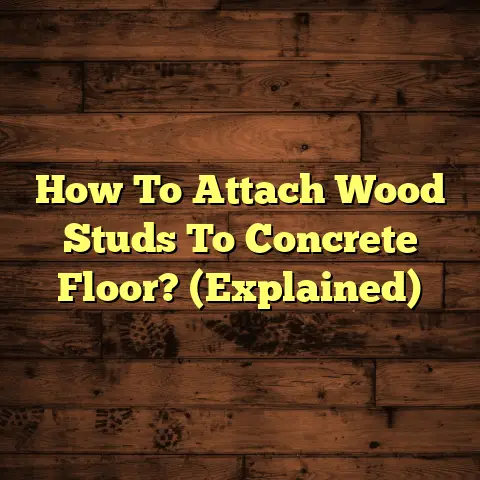Can You Drill Into Concrete Floor?
As a flooring contractor, I’ve seen firsthand the chaos that can ensue when people underestimate the beast that is concrete.
Many folks think drilling into concrete is just like drilling into wood – grab any old drill, slap on a bit, and go to town. Wrong! That’s a recipe for disaster, leading to broken tools, frustrating delays, and potentially dangerous situations.
So, can you drill into concrete? Absolutely! But you need the right knowledge and preparation. Let’s dive in!
Section 1: Understanding Concrete as a Material
1.1 The Composition of Concrete
Concrete isn’t just some gray, solid block. It’s a carefully engineered composite material. Think of it like a cake – you need the right ingredients in the right proportions to get the desired result.
The main ingredients are:
-
Cement: This is the binder that holds everything together. Portland cement is the most common type.
-
Aggregates: These are the “filler” – sand, gravel, or crushed stone. They provide bulk and strength.
-
Water: Water is essential for the chemical reaction (hydration) that hardens the cement.
The magic happens during the curing process. This is where the cement reacts with water to form a hard, stone-like material.
The longer concrete cures, the stronger and denser it becomes. This is why older concrete floors can be particularly challenging to drill into.
1.2 Types of Concrete Floors
Not all concrete floors are created equal. Here’s a quick rundown of some common types:
-
Poured Concrete: This is the most common type, where concrete is poured directly into a form and allowed to cure. It’s often used for basement floors and patios.
-
Concrete Slabs: These are pre-cast concrete panels that are transported to the site and installed. They’re often used in commercial buildings.
-
Reinforced Concrete: This type contains steel rebar (reinforcing bars) embedded within the concrete to increase its strength and resistance to cracking. It’s commonly used in foundations and structural elements.
Knowing the type of concrete you’re dealing with is crucial. Reinforced concrete, for example, requires extra caution to avoid hitting the rebar.
1.3 Properties of Concrete Relevant to Drilling
Concrete is known for its:
-
Hardness: This is its resistance to scratching or indentation. Concrete is significantly harder than wood or drywall.
-
Compressive Strength: This is its ability to withstand pressure. Concrete has very high compressive strength, making it difficult to penetrate.
-
Durability: Concrete is resistant to wear and tear, making it a long-lasting flooring option.
These properties are what make drilling into concrete such a challenge. You need a tool that can overcome the hardness and compressive strength of the material.
Section 2: Tools Required for Drilling into Concrete
Alright, let’s talk tools! This is where many people go wrong. You can’t just use any old drill and expect to get through concrete.
2.1 Types of Drills
Here’s a breakdown of the drills you might encounter:
-
Standard Drill: This is your basic drill, suitable for wood, drywall, and some softer materials. It’s not recommended for concrete. It simply lacks the power and mechanism to effectively penetrate the material.
-
Hammer Drill: This drill adds a hammering action to the rotation, which helps to break up the concrete. It’s a good option for smaller holes and lighter-duty tasks.
-
Rotary Hammer: This is the heavy-duty champion of concrete drilling. It uses a piston mechanism to deliver a powerful hammering force, making it much more effective than a hammer drill. I personally prefer this for most concrete drilling jobs.
Here’s a quick comparison table:
| Feature | Standard Drill | Hammer Drill | Rotary Hammer |
|---|---|---|---|
| Concrete Drilling | Not Recommended | Good (small holes) | Excellent |
| Hammering Action | No | Yes | Yes (Powerful) |
| Hole Size | Small | Small/Medium | Medium/Large |
| Price | Low | Medium | High |
2.2 Drill Bits for Concrete
The drill bit is just as important as the drill itself. Using the wrong bit will lead to frustration and potentially damage your drill.
Here are the main types of drill bits for concrete:
-
Masonry Bits: These are the most basic type of concrete drill bit. They have a carbide tip that helps to chip away at the concrete. They’re suitable for smaller holes and softer concrete.
-
Carbide-Tipped Bits: These bits have a tungsten carbide tip, which is much harder and more durable than standard masonry bits. They’re a good all-around choice for drilling into concrete.
-
Diamond Bits: These are the top-of-the-line bits for drilling into concrete. They have industrial diamonds embedded in the cutting edge, making them incredibly hard and long-lasting. They’re ideal for drilling into very hard concrete or reinforced concrete.
Choosing the right drill bit depends on the hardness of the concrete and the size of the hole you need to drill.
2.3 Additional Tools and Equipment
Don’t forget these essential items:
-
Safety Goggles: Concrete dust is nasty stuff. Protect your eyes!
-
Dust Mask: Breathing in concrete dust can be harmful to your lungs. A dust mask is a must. Consider a respirator for prolonged work.
-
Vacuum: Use a shop vacuum to clean up the dust as you drill. This will help to keep your work area clean and improve visibility.
-
Wall Scanner: This is an optional but highly recommended tool. It can detect rebar, pipes, and electrical wires hidden within the concrete. Trust me, you don’t want to drill into any of those!
Section 3: Preparing to Drill into Concrete
Preparation is key to a successful concrete drilling project. Rushing into it without proper planning is a recipe for disaster.
3.1 Assessing the Project Site
Before you even pick up a drill, take a good look at the area where you’ll be drilling.
-
Check for Pipes and Wires: This is where a wall scanner comes in handy. You don’t want to accidentally drill into a water pipe or electrical wire.
-
Consider the Concrete Type: Is it poured concrete, a slab, or reinforced concrete? This will affect your drilling technique and the type of drill bit you use.
-
Think About What’s Below: Are you drilling into a basement floor? What’s underneath it? You don’t want to drill through the floor and damage something below.
3.2 Marking and Measuring
Accuracy is crucial when drilling into concrete. You want to make sure your holes are in the right place and at the right depth.
-
Use a Pencil or Marker: Mark the exact spot where you want to drill.
-
Use a Template (if needed): If you’re drilling multiple holes, use a template to ensure they’re evenly spaced.
-
Measure Twice, Drill Once: This old adage applies to concrete drilling as well. Double-check your measurements before you start drilling.
3.3 Safety Precautions
Safety should always be your top priority.
-
Wear Safety Gear: Goggles, dust mask, and ear protection are essential.
-
Clear the Area: Make sure there are no children or pets nearby.
-
Use Proper Lighting: You need to be able to see what you’re doing.
-
Be Aware of Noise: Concrete drilling can be loud. Warn your neighbors if you’ll be drilling during certain hours.
Section 4: The Drilling Process
Okay, now we’re ready to drill! But don’t just go blasting away at the concrete. There’s a technique to it.
4.1 Setting Up Your Equipment
-
Choose the Right Drill Bit: Select the appropriate drill bit for the type of concrete and the size of the hole you need to drill.
-
Secure the Drill Bit: Make sure the drill bit is properly secured in the drill chuck.
-
Set the Drill to Hammer Mode (if applicable): If you’re using a hammer drill or rotary hammer, make sure it’s set to the hammer mode.
-
Start Slow: Begin drilling at a slow speed to prevent the bit from slipping.
4.2 Drilling Techniques
-
Apply Consistent Pressure: Don’t force the drill. Let the drill bit do the work. Apply steady, consistent pressure.
-
Use a Hammering Motion: If you’re using a hammer drill or rotary hammer, let the hammering action break up the concrete.
-
Cool the Bit: Concrete drilling generates a lot of heat. Periodically pull the drill bit out of the hole to allow it to cool. You can also dip the bit in water to help cool it down.
-
Clear the Debris: As you drill, the hole will fill with concrete dust and debris. Use a vacuum to clear the debris and keep the bit from binding.
4.3 Troubleshooting Common Issues
-
Bit Slipping: If the bit is slipping, try starting with a smaller pilot hole.
-
Overheating: If the bit is overheating, slow down and allow it to cool more frequently.
-
Excessive Dust: If you’re generating a lot of dust, make sure you’re using a dust mask and vacuum.
-
Hitting Rebar: If you hit rebar, stop drilling immediately. You’ll need to use a different drill bit designed for cutting through metal, or relocate your hole.
Section 5: After Drilling: What to Do Next?
You’ve successfully drilled your hole! But the job isn’t quite done yet.
5.1 Cleaning Up
-
Vacuum the Dust: Thoroughly vacuum up all the concrete dust and debris.
-
Dispose of Waste Materials: Dispose of the concrete dust and debris properly.
5.2 Securing Installation
-
Choose the Right Anchors: Use anchors and screws that are specifically designed for concrete. There are many different types of concrete anchors available, so choose the right one for your application.
-
Install the Anchors: Follow the manufacturer’s instructions for installing the anchors.
-
Secure the Item: Secure the item you’re installing to the anchors.
5.3 Maintenance and Care
-
Monitor for Cracks: Keep an eye on the concrete around the drilled hole for any signs of cracking.
-
Seal the Hole (if needed): If the hole is exposed to the elements, you may want to seal it to prevent water from seeping in.
Conclusion: Recap and Final Thoughts
So, can you drill into concrete floor? Absolutely! But it’s not as simple as drilling into wood or drywall.
You need to:
-
Understand the Material: Know the type of concrete you’re dealing with.
-
Use the Right Tools: Choose a hammer drill or rotary hammer and the appropriate drill bit.
-
Prepare Properly: Assess the project site, mark accurately, and take safety precautions.
-
Drill with Technique: Apply consistent pressure, cool the bit, and clear the debris.
-
Finish the Job: Clean up, secure the installation, and monitor for any issues.
With the right knowledge and preparation, you can successfully drill into concrete floors and tackle your home improvement projects like a pro! Good luck!





